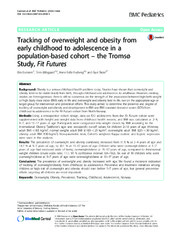Tracking of overweight and obesity from early childhood to adolescence in a population-based cohort – the Tromsø Study, Fit Futures
Permanent lenke
https://hdl.handle.net/10037/9641Dato
2016-05-10Type
Journal articleTidsskriftartikkel
Peer reviewed
Sammendrag
BACKGROUND
Obesity is a serious childhood health problem today. Studies have shown that overweight and obesity tend to be stable (track) from birth, through childhood and adolescence, to adulthood. However, existing studies are heterogeneous; there is still no consensus on the strength of the association between high birth weight or high body mass index (BMI) early in life and overweight and obesity later in life, nor on the appropriate age or target group for intervention and prevention efforts. This study aimed to determine the presence and degree of tracking of overweight and obesity and development in BMI and BMI standard deviation scores (SDS) from childhood to adolescence in the Fit Futures cohort from North Norway.
METHODS
Using a retrospective cohort design, data on 532 adolescents from the Fit Futures cohort were supplemented with height and weight data from childhood health records, and BMI was calculated at 2–4, 5–7, and 15–17 years of age. Participants were categorized into weight classes by BMI according to the International Obesity Taskforce’s age- and sex-specific cut-off values for children 2–18 years of age (thinness: adult BMI <18.5 kg/m 2, normal weight: adult BMI ≥18.5- < 25 kg/m 2, overweight: adult BMI ≥25- < 30 kg/m 2, obesity: adult BMI ≥30 kg/m 2). Non-parametric tests, Cohen’s weighted Kappa statistic and logistic regression were used in the analyses.
RESULTS
The prevalence of overweight and obesity combined, increased from 11.5 % at 2–4 years of age and 13.7 % at 5–7 years of age, to 20.1 % at 15–17 years of age. Children who were overweight/obese at 5–7 years of age had increased odds of being overweight/obese at 15–17 years of age, compared to thin/normal weight children (crude odds ratio: 11.1, 95 % confidence interval: 6.4–19.2). Six out of 10 children who were overweight/obese at 5–7 years of age were overweight/obese at 15–17 years of age.
CONCLUSIONS
The prevalence of overweight and obesity increased with age. We found a moderate indication of tracking of overweight/obesity from childhood to adolescence. Preventive and treatment initiatives among children at high risk of overweight and obesity should start before 5–7 years of age, but general preventive efforts targeting all children are most important.
Beskrivelse
Publisher's version, source: http://doi.org/10.1186/s12887-016-0599-5.


 English
English norsk
norsk